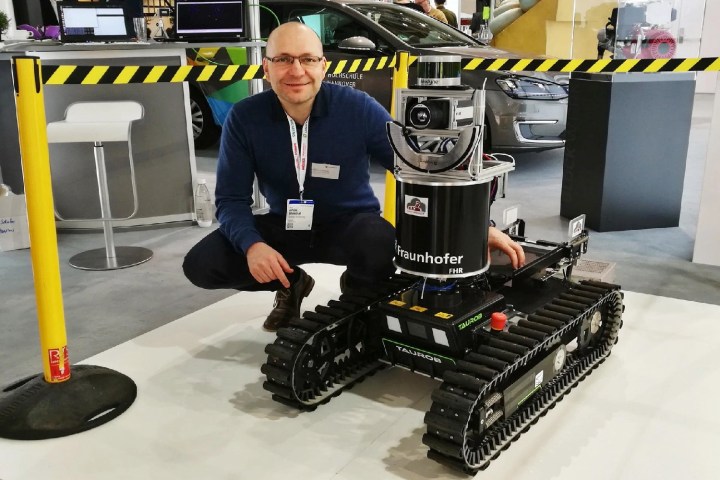Elon Musk’s futuristic “mini-sub” ultimately wasn’t used in the recent daring rescue of 13 people trapped in a cave in Thailand. However, its much-publicized existence reminded the world of the important role similarly cutting-edge technology will increasingly have a role to play in similar disaster rescue efforts.
From inflatable vine robots to skin-sniffing smart sensors, read on for six of the high-tech tools which could one day save your life.
Search and rescue drones
We’ll start with the most common technology on this list: drones. Forget being tools of the future; examples of camera-equipped unmanned aerial vehicles (UAVs) being employed by emergency response teams are already playing out.
Earlier this year, the technology was used to help guide emergency responders to the residence of a resident in Hawaii whose home risked being swallowed up by lava following a volcanic eruption. As drones’ flight time increases, these will only become a more widespread tool in the arsenal of lifesavers.
A growing vine robot
Created by researchers at Stanford University and the University of California, Santa Barbara, this flexible, vine-like robot is capable of growing up to 236 feet in length by pumping itself full of air.
By doing this, it can snake through complex environments, lifting objects, and extending through gaps just 10 percent of its diameter. Because of its hose-like design, the robot could be used for moving materials from rescuers to whoever needed to be rescued.
“One of the areas we’re most interested in is search and rescue,” Professor Elliot Hawkes, lead researcher on the project, told Digital Trends. “We imagine growing the robots through rubble and debris to help find trapped survivors. The robot could deliver water or oxygen to the survivor, and possibly pry rubble off the survivor.”
Harvard’s insect rescue-bots
If you’re in need of a savior in a disaster scenario, what could be a more welcome sight than a rescue robot that’s literally capable of walking on water? That’s what Harvard researchers have developed with its ongoing insect-inspired Harvard’s Ambulatory MicroRobot (HAMR) project.
These miniature rescue bots may be diminutive, but they show off some impressive capabilities, including scampering over ground at high speeds, walking on top of and under water, and — in the future — hopefully climbing and jumping, too.
“Think about a scenario in which a building collapsed due to earthquake or tsunami,” Kevin Chen, a postdoctoral fellow at Harvard University, told Digital Trends. “There are many people trapped in confined and cluttered environments. We can send in a swarm [of hundreds] of these small robots into the site to search for survivors. These robots should be able to overcome obstacles on land. In addition, when facing water puddles, the robots need to bypass these by walking on the water surface or dive down to avoid obstacles on the water surface.”
SmokeBot

No, it’s not a cigar-chomping automaton like Bender from Futurama. Instead, SmokeBot is a robot designed to assist firefighters when they enter smoke-filled buildings. The big selling point of SmokeBot is its ability to spot things firefighters may not — thanks to a combination of gas sensors, radar, a laser scanner, and a thermal camera.
It can then relay this information in the form of maps of its surroundings for assisting fire services or search-and-rescue teams. While the robot has to be remote-controlled by a human user, by way of WiFi, it possesses the smart ability to autonomously return to the last position it had good internet reception if this connection is cut off.
“[We were interested in using robots for] operating in low-visibility environments, a scenario where robots could be very helpful, but in which it was not possible to use them prior to SmokeBot,” Achim Lilienthal, project coordinator and professor of Computer Science at Sweden’s Örebro University, told Digital Trends.
Human-sniffing sensors

Finding survivors in the aftermath of disasters, such as earthquakes or bombings, is a major challenge — with serious time constraints. To help with this, researchers from Austria, Switzerland, and Cyprus have developed an inexpensive sensor designed to literally “sniff out” survivors who may be trapped.
The sensor is both light and portable enough that it could be carried by first responders or mounted onto a drone. It can detect a person’s chemical signature at even the tiniest, trace-level concentrations.
“We tested our sensors in a human entrapment simulation,” Sotiris Pratsinis, Professor of Process Engineering at ETH Zurich in Switzerland, told Digital Trends. “Volunteers were enclosed in a gas-tight chamber to accumulate their breath and skin emissions. The sensors rapidly detected human presence by sensing tiny amounts of these chemicals, at levels unprecedented for portable detectors — down to three parts per billion. The next step is to test the sensor array in the field with first responders under conditions similar to those expected in the aftermath of a calamity.”
MIT’s Cheetah bot
Certainly the coolest-looking robot on this list, Cheetah is a four-legged robot built by MIT engineers. Currently in its third iteration, the 90 lbs Cheetah can handle uneven terrain, make some impressive leaps, and even navigate effectively in pitch black darkness thanks to some smart spatial awareness tech.
The team behind the work hope that it can one day be used as part of rescue missions in disaster relief situations.


